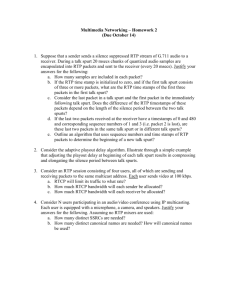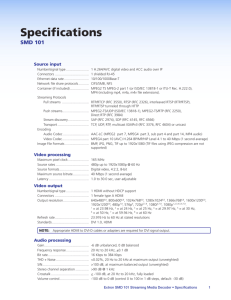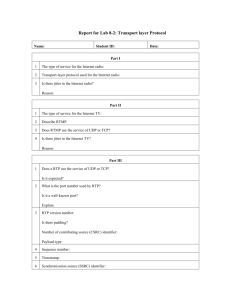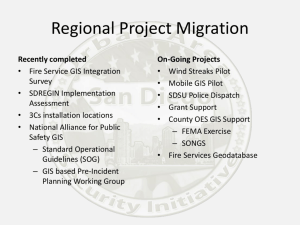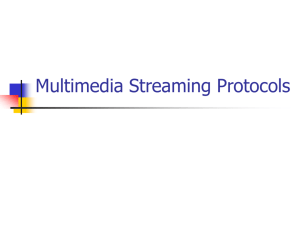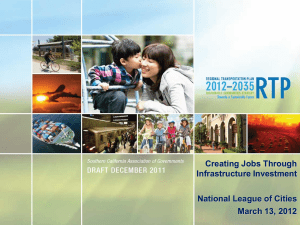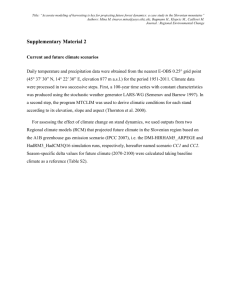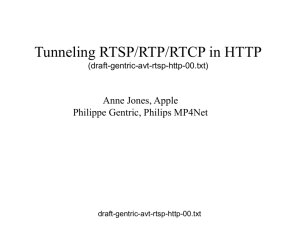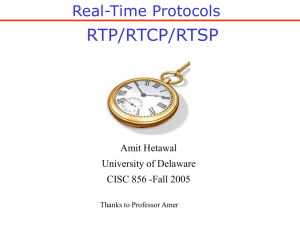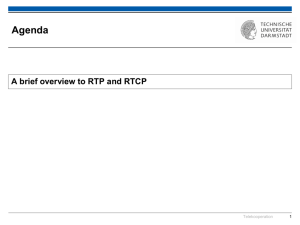soft real time
advertisement
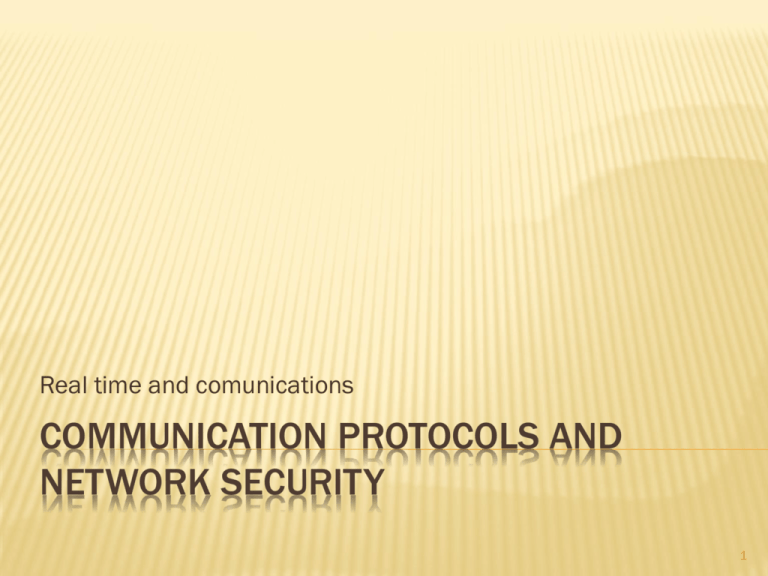
Real time and comunications COMMUNICATION PROTOCOLS AND NETWORK SECURITY 1 CONTENT Examples of use and data capture Network time Basic protocol for real-time traffic Protocol for the management of data flow Secure version of the protocol 2 EXAMPLES OF USE What is real-time (time of arrival, time of implementation, the time required to implement, deadline for completion of performance) Systems hard and soft real time Challenge: Do normal opperating systems FreeBSD, Linux in MS Windows allow work in real time? Justify the answer. 3 EXAMPLES OF USE We will not deal with such a definition of the real-time. Scenarios: We have page A and page B, and between the two, we have the network. On page A we have differen events, that caputre themselves and report to page B through the network. Observer, observing events on page B, must have trust in what he sees. We can transfere the content of the events, the problem is to transfer the effect of time between the events. 4 SCENARIOS 5 EXAMPLES OF USE One way communication: Presentation of slides, ... Playing sound (remoteCD) and playing movie(remote VCR) Combining picture and sound at transfer. Broadcasting radio or TV program. Two way communication Chatting via internet(VoIP) video telephony 6 CAPTURE OF DATA – SOUND Sound is an analog phenomenon of changing air pressure, perceived by the human ear. Before digital: We changed analog audio signal via microphone into an analog electrical signal. Electrical signal was then used for the production of sound through the speaker. 7 CAPTURE OF DATA – SOUND Digital: We still capture sound but only in discreete moments – We capture deviation (amplitude, intensity, energy) Amplitude is then transformed into n-bit number Challenge: find the audacity program, install it, and then capture and process the sound. 8 CAPTURE OF DATA – SOUND Sound, of course, is not a simple sine phenomenon, but it is a linear combination of multiple sinusoidal signals: the sum of ak sin(kω) Digital capture of signal must notloose (to much) singal information. 9 CAPTURE OF DATA – SOUND Sampling problem(Nyquist-ova frequency) The human ear perceives frequencies of approximately 20Hz do 22kHz Challenge: Why are cars rotating wheels in the movies go sometimes back, while car or wagon is moving forward? Challenge: What is the sampling frequency for wav files? The human ear can not detect certain combinations of signals mp3 compressing Challenge: Search program with the command line interface for mp3 compression for Unix and install it? 10 CAPTURE OF DATA – PICTURE Problem of digitizing one picture and then the movie. Digitizing picture: each point on the screen has a value that is three dimensional vector Challenge: Which can be the three dimenssions of vector (more options)? What do they mean? Challenge: Check different standards like jpg, gif, pgn, and comment them. How is the conversion between them? So digitized image represents an example of one amplitude of sound The problem of time digitizing equals / is the same as it is in sound Human eye can sense movement if he receives at least between 23 to 25 pictures of the second Challenge: What are the standard sampling speeds? Are there more, where are they beeing used? Why are they different? Challenge: check out the different standards of movie records and comment them. How is the conversion between them? 11 NETWORK TIME Sometimes we must synchronise time between multiple remote systems. Problem of data transfer delay. You can use multiple systems simultaneously. 12 PROTOCOL NTP Defined in RFC 5905, Network Time Protocol Version 4: Protocol and Algorithms Specification Mandatory: Find it on the internet and read it – literature! Challenge: Find other RFC documents, dealing with ntp and check, what is written in them. Find description of Marzullov algorythm. 13 SOFTWARE On FreeBSD: ntpd Configuration in /etc/ntp.conf server ntplocal.example.com prefer server timeserver.example.org server ntp2a.example.net driftfile /var/db/ntp.drift • • • Challenge: Find servers in Slovenia? Challenge: find manual and run client. Manually change the time and watch what will happen. Challenge: How to use ntpd on OS Windows? 14 TRANSFER FROM A TO B Possible solutions: A records the events and time stamps and sends the file to B. A, when he records the event, he puts stamp on the record and sends it to B. Somethin in between. Main problem is network. 15 THE IMPACT OF NETWORK Our network is packet based Each packet can travel on different route Each packet can arrive in different time latency problem– is not so big in one-way traffic Some packets can get lost Two problems: What to do with lost packages Network transport layer or aplication layer handles lost packets What to do with uneven packet arrival Some packets can simply be late 16 THE IMPACT OF NETWORK Two problems What to do with lost packages. What to do with uneven packet arrival Solution: Late packages adress as lost Protocol should provide a time balance Application should arrange packet loss 17 PROTOCOL RTP Defined in RFC 3550, RTP: A Transport Protocol for Real-Time Applications Mandatory: Find it on the internet and read it – literature! Challenge: Find other RFC documents, dealing with tftp and check, what is written in them. Basic funcionality: ensures the correct sequence of the packets concern for time stamp events 18 PROTOCOL RTP Additional functionality: On connection can have multiple data flows (sources of events): soud left, sound right, ...; picture from right eye, picture from left eye; subtitles, ... Identificator of source / session and his synchronization source Special element– mixer, that can combine more sessions to one. In combined session, whom the package belong to. 19 RTP – SOME DETAILS rtp is transport protocol, that serves for data transfer. does not include commands to initiate connections and maintain connections rtp protocol allows application to transport special data (for playing sound, music, ...) – profile For control of RTP protocol, it uses RTCP protocol(RTP Control Protocol) – same RFC rtp uses on transport layer connectionless mode – UDP protocol 20 RTP – PACKAGE FORM 0 1 2 3 0 1 2 3 4 5 6 7 8 9 0 1 2 3 4 5 6 7 8 9 0 1 2 3 4 5 6 7 8 9 0 1 +-+-+-+-+-+-+-+-+-+-+-+-+-+-+-+-+-+-+-+-+-+-+-+-+-+-+-+-+-+-+-+-+ |V=2|P|X| CC |M| PT | sequence number | +-+-+-+-+-+-+-+-+-+-+-+-+-+-+-+-+-+-+-+-+-+-+-+-+-+-+-+-+-+-+-+-+ | timestamp | +-+-+-+-+-+-+-+-+-+-+-+-+-+-+-+-+-+-+-+-+-+-+-+-+-+-+-+-+-+-+-+-+ | synchronization source (SSRC) identifier | +=+=+=+=+=+=+=+=+=+=+=+=+=+=+=+=+=+=+=+=+=+=+=+=+=+=+=+=+=+=+=+=+ | contributing source (CSRC) identifiers | | .... | +-+-+-+-+-+-+-+-+-+-+-+-+-+-+-+-+-+-+-+-+-+-+-+-+-+-+-+-+-+-+-+-+ | defined by profile | length | +-+-+-+-+-+-+-+-+-+-+-+-+-+-+-+-+-+-+-+-+-+-+-+-+-+-+-+-+-+-+-+-+ | header extension | | .... | Basis: • V – version; 2 • P – padding • sequence number – sequencing packages sent in flow. • timestamp – Time stamp of the event. 21 RTP – PACKAGE FORM 0 1 2 3 0 1 2 3 4 5 6 7 8 9 0 1 2 3 4 5 6 7 8 9 0 1 2 3 4 5 6 7 8 9 0 1 +-+-+-+-+-+-+-+-+-+-+-+-+-+-+-+-+-+-+-+-+-+-+-+-+-+-+-+-+-+-+-+-+ |V=2|P|X| CC |M| PT | sequence number | +-+-+-+-+-+-+-+-+-+-+-+-+-+-+-+-+-+-+-+-+-+-+-+-+-+-+-+-+-+-+-+-+ | timestamp | +-+-+-+-+-+-+-+-+-+-+-+-+-+-+-+-+-+-+-+-+-+-+-+-+-+-+-+-+-+-+-+-+ | synchronization source (SSRC) identifier | +=+=+=+=+=+=+=+=+=+=+=+=+=+=+=+=+=+=+=+=+=+=+=+=+=+=+=+=+=+=+=+=+ | contributing source (CSRC) identifiers | | .... | +-+-+-+-+-+-+-+-+-+-+-+-+-+-+-+-+-+-+-+-+-+-+-+-+-+-+-+-+-+-+-+-+ | defined by profile | length | +-+-+-+-+-+-+-+-+-+-+-+-+-+-+-+-+-+-+-+-+-+-+-+-+-+-+-+-+-+-+-+-+ | header extension | | .... | Additional functionalities: • SSRC –Synchronization source • • CC – number of mixed sources CSRC –Contributing source 22 RTP – PACKAGE FORM 0 1 2 3 0 1 2 3 4 5 6 7 8 9 0 1 2 3 4 5 6 7 8 9 0 1 2 3 4 5 6 7 8 9 0 1 +-+-+-+-+-+-+-+-+-+-+-+-+-+-+-+-+-+-+-+-+-+-+-+-+-+-+-+-+-+-+-+-+ |V=2|P|X| CC |M| PT | sequence number | +-+-+-+-+-+-+-+-+-+-+-+-+-+-+-+-+-+-+-+-+-+-+-+-+-+-+-+-+-+-+-+-+ | timestamp | +-+-+-+-+-+-+-+-+-+-+-+-+-+-+-+-+-+-+-+-+-+-+-+-+-+-+-+-+-+-+-+-+ | synchronization source (SSRC) identifier | +=+=+=+=+=+=+=+=+=+=+=+=+=+=+=+=+=+=+=+=+=+=+=+=+=+=+=+=+=+=+=+=+ | contributing source (CSRC) identifiers | | .... | +-+-+-+-+-+-+-+-+-+-+-+-+-+-+-+-+-+-+-+-+-+-+-+-+-+-+-+-+-+-+-+-+ | defined by profile | length | +-+-+-+-+-+-+-+-+-+-+-+-+-+-+-+-+-+-+-+-+-+-+-+-+-+-+-+-+-+-+-+-+ | header extension | | .... | Higher protocol/application: • PT – protocol identification • M – special bit for needs of protocol • • • X – presence of header extension Last part of header extension Challange: Find RFC for protocol description (modes of transport), that use RTP and compare them (sound, movie, text!, ...) 23 THE CONTROL PROTOCOL RTCP Compare analogy between IP and IPCP Has four funcions: 1. 2. 3. 4. Reports on the quality of traffic(RR: receiver report and SR: sender report Extra description of event flow(SDES: Source description items) responsible for the proper density messaging on quality of transport Can transport other application packets (APP: Application-specific functions) 24 THE CONTROL PROTOCOL RTCP For use of RTCP we must maintain stable bandwidth If there are a lot of partys (multicast), then the density of reporting is smaller Challenge: What kind of data can RTCP send about event source? What is CNAME? Challenge: How does traffic quality report look like?What kind of data does he have? 25 RTCP – PACKAGE FORM 0 1 2 3 0 1 2 3 4 5 6 7 8 9 0 1 2 3 4 5 6 7 8 9 0 1 2 3 4 5 6 7 8 9 0 1 +-+-+-+-+-+-+-+-+-+-+-+-+-+-+-+-+-+-+-+-+-+-+-+-+-+-+-+-+-+-+-+-+ |V=2|P| var | PT | length | +-+-+-+-+-+-+-+-+-+-+-+-+-+-+-+-+-+-+-+-+-+-+-+-+-+-+-+-+-+-+-+-+ | .... | • • Challenge: What is the value of var • in SR command and what does it mean? Challenge: Peter Zmeda has found • out that there is connection between RTP, freebsd and mplayer? What kind? Install mplayer and try it. V – verison; 2 P – padding PT – command: SR, RR, SDES, BYE, APP var – different values, depends on command. 26 SAFE RTP RTP protocol uses UDP transfer, who do not have sll layer. So we must implement saftey in RTP by our self We exchange keys, but packages get lost Different way of encryption: encryption with cypher flow 27 ENCRYPTION WITH CYPHER FLOW Starting values(IV) is know to both sides Both sides also know the key Each packed is separately encrypted + is simple xor or something similar If packet is lost, we swirl emty E 28 PROTOCOL SRTP Defined in RFC 3711, The Secure Real-time Transport Protocol (SRTP) Mandatory: Find it on the internet and read it – literature! Challenge: Find other RFC documents, dealing with srtp and check, what is written in them. based on RTP Security added with cyphering a flow of cyphres Challenge: How do they exchange keys? Challenge: In RFC there is mention about HMAC function(RFC 2104); how does it work and how we use it? What is f8, which is mentioned in standard? 29 USERS OF RTP PROTOCOL Event Logging in (distant) laboratories (gridcc) IP telephony– SIP Remote VCR or VoD Uses protocol RTSP 30 PROTOCOL RTSP Defined in RFC 2326, Real Time Streaming Protocol (RTSP) Mandatory: Find it on the internet and read it – literature! Challenge: Find other RFC documents, dealing with RTSP and check, what is written in them. Basic commands: set (SETUP), play and/or record(PLAY, RECORD), wait(PAUSE) and stop(TEARDOWN) additional commands for setting and reading parameters Example of use on websites: <a href=“rtsp://tainta.isp.ponudnik/Dolina_miru”>prelep slovenski film </a> ,, relative’’ of protocol http: same structure of commands (MIME) Challenge: on of fields, that client sets in server request is transport. How does it look like and what does it do? Challenge: Where can we see connection between RTSP in RTP – for example in RTP we had in header SSRC field; does it exist in RTSP and if yes where is it and how does it look like? 31 SOFTWARE One of first opensource servers is Darwin What about the client? • Challenge: find server and install it on yourFreeBSD/Linux system. Add a site that offers your movies. 32 CONCLUSION We looked at what really means “real time'' and how to adjust time on your computer. We looked RTP/RTCP protocol and its safe version SRTP We looked the use of RTP protocol for VoD, that uses protocol RTSP Next time: multicasting Ufff, how does application handles lost packets(look at the tasks left to application)? 33
